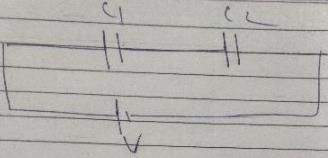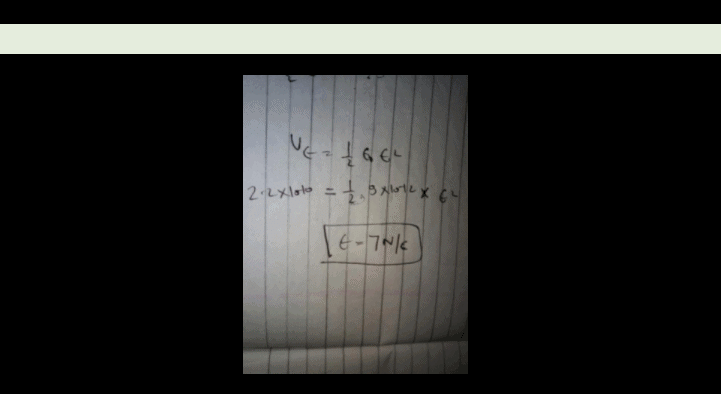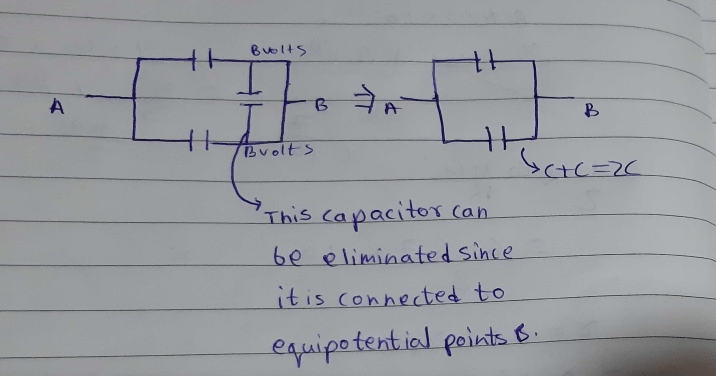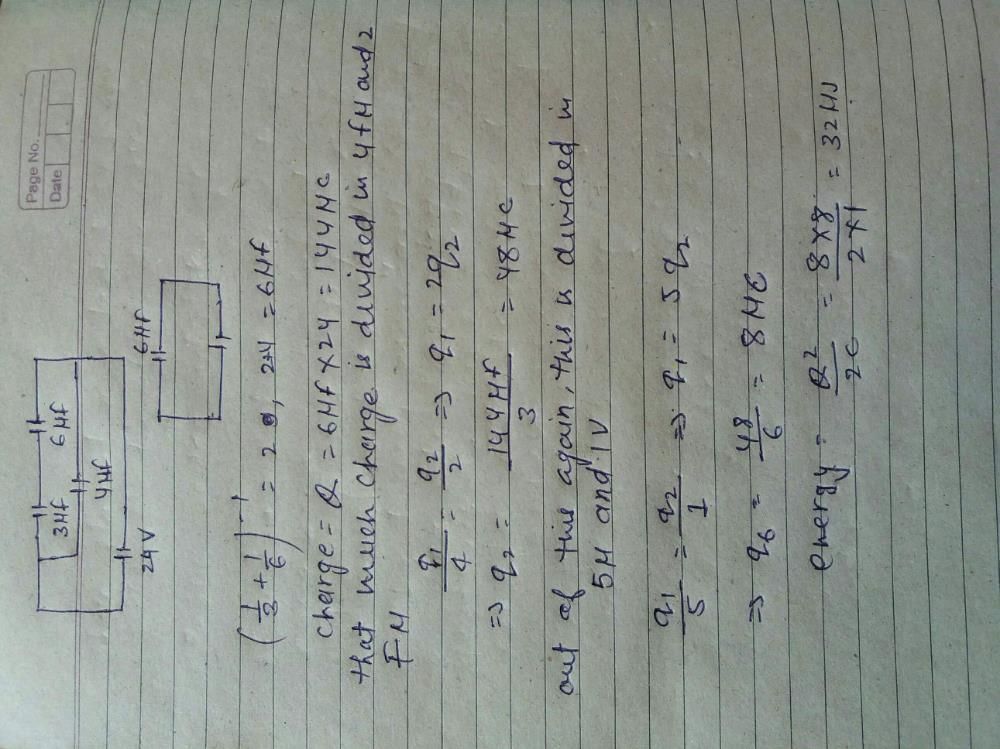All Exams >
EmSAT Achieve >
Physics for EmSAT Achieve >
All Questions
All questions of Capacitors, Capacitance and Dielectrics for EmSAT Achieve Exam
The electric field inside a dielectric decreases, when it is placed in an external electric field. This happens due to- a)Electrostatic shielding
- b)Polarization
- c)Electrostatic repulsion between atoms
- d)Electrostatic attraction between atoms
Correct answer is option 'B'. Can you explain this answer?
The electric field inside a dielectric decreases, when it is placed in an external electric field. This happens due to
a)
Electrostatic shielding
b)
Polarization
c)
Electrostatic repulsion between atoms
d)
Electrostatic attraction between atoms

|
Infinity Academy answered |
The external electric field polarizes the dielectric and an electric field is produced.
The net electric field inside the dielectric decreases due to polarization.
The net electric field inside the dielectric decreases due to polarization.
Three different capacitors are connected in series, then:- a)they will have equal charges
- b)they will have same potential
- c)both 1 & 2
- d)none of these
Correct answer is option 'A'. Can you explain this answer?
Three different capacitors are connected in series, then:
a)
they will have equal charges
b)
they will have same potential
c)
both 1 & 2
d)
none of these
|
|
Mira Joshi answered |
C = Q/V
series connection splits the battery potential, hence....
V = V1 + V2
V1 = Q/C1 & V2 = Q/C2
Therefore, both have equal charge
series connection splits the battery potential, hence....
V = V1 + V2
V1 = Q/C1 & V2 = Q/C2
Therefore, both have equal charge
What should be the radius of an isolated spherical conductor so that it has a capacity of 2μF?- a)1.8X105 m
- b)1.8X104 m
- c)2.5X104 m
- d)2.5X105 m
Correct answer is option 'B'. Can you explain this answer?
What should be the radius of an isolated spherical conductor so that it has a capacity of 2μF?
a)
1.8X105 m
b)
1.8X104 m
c)
2.5X104 m
d)
2.5X105 m

|
Gunjan Lakhani answered |
Capacitance of an isolated spherical conductor =4π€R , where €=permittivity of vacuum
C=2×10-6F
C=4π€R
4×3.14×8.85×10-12×R=2×10-6
R=2×10-6/4×3.14×8.85×10-12
=1.8×104 m
C=2×10-6F
C=4π€R
4×3.14×8.85×10-12×R=2×10-6
R=2×10-6/4×3.14×8.85×10-12
=1.8×104 m
Which of the following is a non polar dielectric?- a)Water
- b)Alcohol
- c)HCl
- d)Benzene
Correct answer is option 'D'. Can you explain this answer?
Which of the following is a non polar dielectric?
a)
Water
b)
Alcohol
c)
HCl
d)
Benzene
|
|
Riya Banerjee answered |
Alcohol and HCl are polar molecules since they have a net dipole moment towards a particular direction. Both water and benzene are non-polar molecules. But water is a conductor of electricity, whereas benzene is a dielectric (insulator).
What will be the effect on capacitance, if the distance between the parallel plates reduced to one-third of its original value?- a)decrease by a factor 3
- b)increase by a factor 3
- c)increase by a factor 3/2
- d)increase by a factor ½
Correct answer is option 'B'. Can you explain this answer?
What will be the effect on capacitance, if the distance between the parallel plates reduced to one-third of its original value?
a)
decrease by a factor 3
b)
increase by a factor 3
c)
increase by a factor 3/2
d)
increase by a factor ½
|
|
Preeti Khanna answered |
C=(Kε0A/d)∝K/d
Hence,C1/C2=d2/d1=(d/3)d=3
C2=3C1
Hence,C1/C2=d2/d1=(d/3)d=3
C2=3C1
1 microfarad is equal to- a)10-6F
- b)10-12F
- c)10-15F
- d)10-9F
Correct answer is option 'A'. Can you explain this answer?
1 microfarad is equal to
a)
10-6F
b)
10-12F
c)
10-15F
d)
10-9F
|
|
Lavanya Menon answered |
The microfarad (symbolized µF) is a unit of capacitance, equivalent to 0.000001 (10 to the -6th power) farad.
The polarized dielectric is equivalent to- a)non-zero volume charge density
- b)one charged surface with induced surface charge density
- c)two charged surfaces with induced surface charge densities
- d)zero surface charge density
Correct answer is option 'C'. Can you explain this answer?
The polarized dielectric is equivalent to
a)
non-zero volume charge density
b)
one charged surface with induced surface charge density
c)
two charged surfaces with induced surface charge densities
d)
zero surface charge density

|
Learners Habitat answered |
A polarized dielectric is equivalent to two charged surfaces with induced charges (polarization charges).
Five capacitors are connected as shown in the figure. Initially S is opened and all capacitors are uncharged. When S is closed, steady state is obtained. Then find out potential difference between the points M and N. 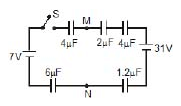
- a)14
- b)12
- c)10
- d)15
Correct answer is option 'B'. Can you explain this answer?
Five capacitors are connected as shown in the figure. Initially S is opened and all capacitors are uncharged. When S is closed, steady state is obtained. Then find out potential difference between the points M and N.
a)
14
b)
12
c)
10
d)
15
|
|
Krishna Iyer answered |
Five capacitors 4μF, 2μF, 4μF, 6μF and 1.2μF are connected as shown in the figure.
Here, Equivalent capacitance = ½,
EMF = 24
Thus, charge passes through each capacitor = 12 μC
Voltage across 4μF = 3V
Voltage across 6μF = 2V
=> Potential difference (V):
V = 3 + 7+ 2 = 12V
Thus, potential difference (V) between the two given points M and N is 12v.
Here, Equivalent capacitance = ½,
EMF = 24
Thus, charge passes through each capacitor = 12 μC
Voltage across 4μF = 3V
Voltage across 6μF = 2V
=> Potential difference (V):
V = 3 + 7+ 2 = 12V
Thus, potential difference (V) between the two given points M and N is 12v.
Two capacitors of 20 μƒ and 30 μƒ are connected in series to a battery of 40V. Calculate charge on each capacitor.- a)480 C
- b)478 C
- c)450 C
- d)500 C
Correct answer is option 'A'. Can you explain this answer?
Two capacitors of 20 μƒ and 30 μƒ are connected in series to a battery of 40V. Calculate charge on each capacitor.
a)
480 C
b)
478 C
c)
450 C
d)
500 C
|
|
Nikita Singh answered |
C1= 20×10µf
and C2= 30×10µf
in series Ceq = C1C2/(C1+C2)
Ceq = 20×10^(-6)×30×10^(-6)/20×10^(-6)+30^×10(-6)
Ceq= 12×10^(-6)f
As we know that Q = CV
Putting the values of C and V= 40V, we get
Q = (12 * 10^-6) * 40
= 480µC
Here is a combination of three identical capacitors. If resultant capacitance is 1 μƒ, calculate capacitance of each capacitor.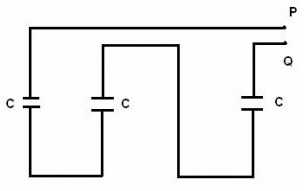
- a)6 μƒ
- b)3 μƒ
- c)4 μƒ
- d)2 μƒ
Correct answer is option 'B'. Can you explain this answer?
Here is a combination of three identical capacitors. If resultant capacitance is 1 μƒ, calculate capacitance of each capacitor.
a)
6 μƒ
b)
3 μƒ
c)
4 μƒ
d)
2 μƒ
|
|
Lavanya Menon answered |
Combination of Capacitors in Series
C(effective) = C/3 = 1
C(effective) = C/3 = 1
When two capacitors C1 and C2 are connected in series and parallel, their equivalent capacitances comes out to be 3 μƒ and 16 μƒ respectively. Calculate values of C1 and C2.- a)4μƒ and 12μƒ
- b)6μƒ and 10μƒ
- c)4μƒ and 10μƒ
- d)6μƒ and 12μƒ
Correct answer is option 'A'. Can you explain this answer?
When two capacitors C1 and C2 are connected in series and parallel, their equivalent capacitances comes out to be 3 μƒ and 16 μƒ respectively. Calculate values of C1 and C2.
a)
4μƒ and 12μƒ
b)
6μƒ and 10μƒ
c)
4μƒ and 10μƒ
d)
6μƒ and 12μƒ

|
Anonymous answered |
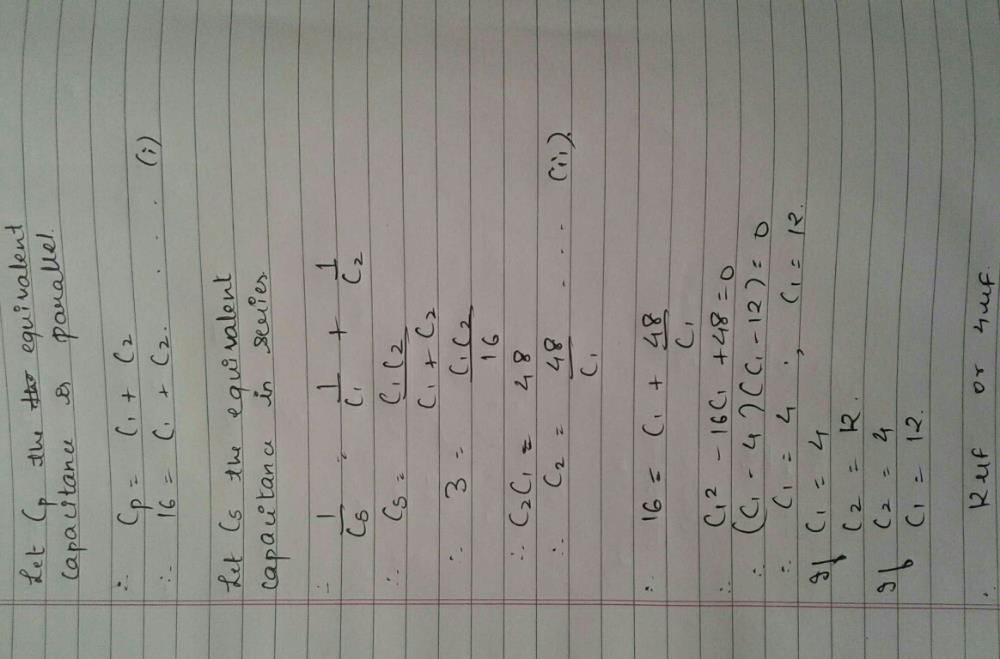
Three uncharged capacitors of capacitane C1 = 1mF, C2 = 2mF and C3 = 3mF are connected as shown in figure to one another and to points A, B and D potential fA = 10V, fB = 25V and fD = 20 V, Determine the potential (f0) at point O.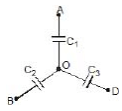
- a)20 V
- b)30 V
- c)40 V
- d)10 V
Correct answer is option 'A'. Can you explain this answer?
Three uncharged capacitors of capacitane C1 = 1mF, C2 = 2mF and C3 = 3mF are connected as shown in figure to one another and to points A, B and D potential fA = 10V, fB = 25V and fD = 20 V, Determine the potential (f0) at point O.
a)
20 V
b)
30 V
c)
40 V
d)
10 V
|
|
Lavanya Menon answered |
⇒q1+q2+q3=0
⇒C1(Vo−VA)+C2(Vo−VB)+C3(Vo−VD)=0
⇒(C1+C2+C3)Vo=C1VA+C2VB+C3VD
Vo= C1VA+C2VB+C3VD/ C1+C2+C3
= [(1×10)+(2×25)+(3×20)]/(1+2+3)
=(10+50+60)/6
=20Volts
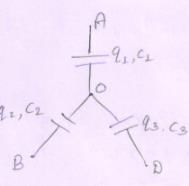
⇒C1(Vo−VA)+C2(Vo−VB)+C3(Vo−VD)=0
⇒(C1+C2+C3)Vo=C1VA+C2VB+C3VD
Vo= C1VA+C2VB+C3VD/ C1+C2+C3
= [(1×10)+(2×25)+(3×20)]/(1+2+3)
=(10+50+60)/6
=20Volts

A conductor of capacitance 0.5mF has been charged to 100volts. It is now connected to uncharged conductor of capacitance 0.2mF. The loss in potential energy is nearly- a)7 × 10_4 J
- b)3.5 × 10_4 J
- c)14 × 10_4 J
- d)7 × 10_3 J
Correct answer is option 'A'. Can you explain this answer?
A conductor of capacitance 0.5mF has been charged to 100volts. It is now connected to uncharged conductor of capacitance 0.2mF. The loss in potential energy is nearly
a)
7 × 10_4 J
b)
3.5 × 10_4 J
c)
14 × 10_4 J
d)
7 × 10_3 J
|
|
Jyoti Sengupta answered |
Given,
C1=0.5 mf
C2=0.2mf
V=100v
So,
U=(1/2) CTV2
CT=C1C2/XC1+C2=(0.5x0.2/0.5+0.2)mf
CT=0.14mf
U=(1/2)(0.14mf)(100V)2
=(10.07x1-6x104)J
=(7x10-2x10-6x104)J
=7x10-4J
C1=0.5 mf
C2=0.2mf
V=100v
So,
U=(1/2) CTV2
CT=C1C2/XC1+C2=(0.5x0.2/0.5+0.2)mf
CT=0.14mf
U=(1/2)(0.14mf)(100V)2
=(10.07x1-6x104)J
=(7x10-2x10-6x104)J
=7x10-4J
Can you explain the answer of this question below:In a parallel plate capacitor the potential difference of 150 V is maintained between the plates. If distance between the plates is 6 mm, what will be the electric field at points A and B?
- A:
2.5×103
- B:
2.5×104
- C:
2.5×105
- D:
3.5×104
The answer is b.
In a parallel plate capacitor the potential difference of 150 V is maintained between the plates. If distance between the plates is 6 mm, what will be the electric field at points A and B?
2.5×103
2.5×104
2.5×105
3.5×104
|
|
Om Desai answered |
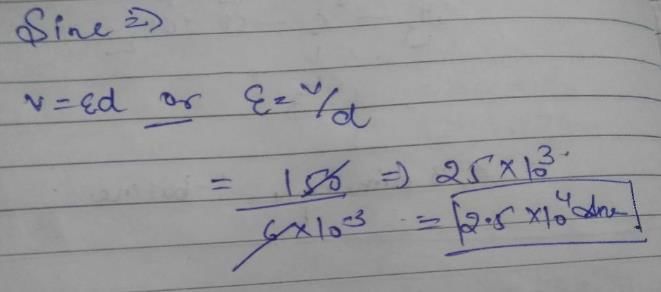
μμf is also called?- a)nanofarad
- b)microfarad
- c)picofarad
- d)fermifarad
Correct answer is option 'C'. Can you explain this answer?
μμf is also called?
a)
nanofarad
b)
microfarad
c)
picofarad
d)
fermifarad
|
|
Arghya answered |
10^(-6)=microfarad.... so ,10^(-6)*10^(-6)=10^(-12)=PICOFARAD
The distance between the plates of a capacitor is d. What will be the new capacitance if a metal plate of thickness d/2 is introduced between the plates without touching them- a)it will be thrice of its initial value
- b)it will be double of its initial value
- c)remains the same
- d)it will be half of its initial value
Correct answer is option 'B'. Can you explain this answer?
The distance between the plates of a capacitor is d. What will be the new capacitance if a metal plate of thickness d/2 is introduced between the plates without touching them
a)
it will be thrice of its initial value
b)
it will be double of its initial value
c)
remains the same
d)
it will be half of its initial value
|
|
Nisha Patel answered |
Explanation:
Capacitance of a capacitor:
The capacitance of a capacitor is given by the equation:
C = εA/d
where C is the capacitance, ε is the permittivity of the medium between the plates, A is the area of the plates, and d is the distance between the plates.
Effect of introducing a metal plate:
When a metal plate of thickness d/2 is introduced between the plates without touching them, the distance between the plates decreases by d/2. This means that the new distance between the plates is d/2.
New capacitance:
Using the equation for capacitance, we can calculate the new capacitance as:
C' = εA/(d/2)
C' = 2εA/d
The new capacitance is double the initial capacitance. Therefore, the correct answer is option B, "it will be double of its initial value."
Capacitance of a capacitor:
The capacitance of a capacitor is given by the equation:
C = εA/d
where C is the capacitance, ε is the permittivity of the medium between the plates, A is the area of the plates, and d is the distance between the plates.
Effect of introducing a metal plate:
When a metal plate of thickness d/2 is introduced between the plates without touching them, the distance between the plates decreases by d/2. This means that the new distance between the plates is d/2.
New capacitance:
Using the equation for capacitance, we can calculate the new capacitance as:
C' = εA/(d/2)
C' = 2εA/d
The new capacitance is double the initial capacitance. Therefore, the correct answer is option B, "it will be double of its initial value."
Two capacitors of 2mF and 3mF are charged to 150 volt and 120 volt respectively. The plates of capacitor are connected as shown in the figure. A discharged capacitor of capacity 1.5 mF falls to the free ends of the wire. Then 
- a) Charge on the 1.5 mF capacitor is 180 mC
- b)Charge on the 2 mF capacitor is 120 mC
- c)Charge flows through A from right to left
- d)Charge flows through A from left to right
Correct answer is option 'A,B,C'. Can you explain this answer?
Two capacitors of 2mF and 3mF are charged to 150 volt and 120 volt respectively. The plates of capacitor are connected as shown in the figure. A discharged capacitor of capacity 1.5 mF falls to the free ends of the wire. Then
a)
Charge on the 1.5 mF capacitor is 180 mC
b)
Charge on the 2 mF capacitor is 120 mC
c)
Charge flows through A from right to left
d)
Charge flows through A from left to right
|
|
Neha Sharma answered |
Charge in 2μF Capacitor =300μC
Charge in 3μF Capacitor =360μC
when 1.5μF falls on the circuit ends, Redistribution of charge now will be:
Charge in 2μF Capacitor =300−xμC
Charge in 3μF Capacitor =360−xμC
Charge in 1.5μF Capacitor =xμC
By Kirchhoff Voltage Law:
x/1.5=[(300−x)/2]+[(360−x)/3]
which gives x=180μC
Therefore, Answers are A, B & C
Charge in 3μF Capacitor =360μC
when 1.5μF falls on the circuit ends, Redistribution of charge now will be:
Charge in 2μF Capacitor =300−xμC
Charge in 3μF Capacitor =360−xμC
Charge in 1.5μF Capacitor =xμC
By Kirchhoff Voltage Law:
x/1.5=[(300−x)/2]+[(360−x)/3]
which gives x=180μC
Therefore, Answers are A, B & C
Two capacitors of equal capacitance (C1 = C2) are shown in the figure. Initially, while the switch S is open, one of the capacitors is uncharged and the other carries charge Q0. The energy stored in the charged capacitor is U0. Sometimes after the switch is colsed, the capacitors C1 and C2 carry charges Q1 and Q2, respectively, the voltages across the capacitors are V1 and V2, and the energies stored in the capacitors are U1 and U2. Which of the following statements is INCORRECT ?
- a)

- b)Q1 = Q2
- c)V1 = V2
- d)U0 = U1 + U2
Correct answer is option 'D'. Can you explain this answer?
Two capacitors of equal capacitance (C1 = C2) are shown in the figure. Initially, while the switch S is open, one of the capacitors is uncharged and the other carries charge Q0. The energy stored in the charged capacitor is U0. Sometimes after the switch is colsed, the capacitors C1 and C2 carry charges Q1 and Q2, respectively, the voltages across the capacitors are V1 and V2, and the energies stored in the capacitors are U1 and U2. Which of the following statements is INCORRECT ?
a)
b)
Q1 = Q2
c)
V1 = V2
d)
U0 = U1 + U2
|
|
Suresh Iyer answered |
In the above diagram, C1 and C2 are connected in parallel.
Hence, both get the same voltage. ∴V1=V2 is correct.
We know that Q1=C1V1 and Q2=C2V2
∵C1=C2, Q1=Q2
We know that energy U1=(1/2)C1V12 and U2=(1/2)C2V22
By closing the switch, the C1 or V1 doesn't get affected.
Hence U0=U1 and not U1+U2
Similarly, by closing the switch, the Q1 or V1 doesn't get affected.
Hence Q0=Q1
∵Q0=Q1=Q2, Q0=(1/2)(Q1+Q2)
Hence, both get the same voltage. ∴V1=V2 is correct.
We know that Q1=C1V1 and Q2=C2V2
∵C1=C2, Q1=Q2
We know that energy U1=(1/2)C1V12 and U2=(1/2)C2V22
By closing the switch, the C1 or V1 doesn't get affected.
Hence U0=U1 and not U1+U2
Similarly, by closing the switch, the Q1 or V1 doesn't get affected.
Hence Q0=Q1
∵Q0=Q1=Q2, Q0=(1/2)(Q1+Q2)
A parallel plate capacitor of capacitance C is connected to a battery and is charged to a potential difference V. Another capacitor of capacitance 2C is similarly charged to a potential difference 2V. The charging battery is now disconnected and the capacitors are connect in parallel to each other in such a way that the positive terminal of one is connected to the negative terminal of the other. The final energy of the configuration is- a)zero
- b)
 CV2
CV2 - c)
 CV2
CV2 - d)
 CV2
CV2
Correct answer is option 'B'. Can you explain this answer?
A parallel plate capacitor of capacitance C is connected to a battery and is charged to a potential difference V. Another capacitor of capacitance 2C is similarly charged to a potential difference 2V. The charging battery is now disconnected and the capacitors are connect in parallel to each other in such a way that the positive terminal of one is connected to the negative terminal of the other. The final energy of the configuration is
a)
zero
b)
c)
d)
|
|
Nikita Singh answered |
Where N is the number of turns of the toroid coil, I is the amount of current flowing and r is the radius of the toroid.
As both capacitors are in parallel so equivalent capacitance Ceq=C+2C=3C .
Net potential, Vn=2V−V=V
Energy stored, U=(1/2)CeqVn2=(1/2)×3CV2=(3/2)CV2
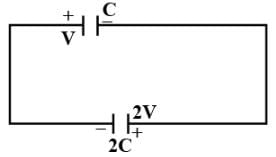
As both capacitors are in parallel so equivalent capacitance Ceq=C+2C=3C .
Net potential, Vn=2V−V=V
Energy stored, U=(1/2)CeqVn2=(1/2)×3CV2=(3/2)CV2

Find the equivalent capacitance of the combination.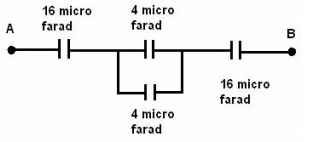
- a)16/3 μƒ
- b)16 μƒ
- c)19.0 μƒ
- d)8 μƒ
Correct answer is option 'C'. Can you explain this answer?
Find the equivalent capacitance of the combination.
a)
16/3 μƒ
b)
16 μƒ
c)
19.0 μƒ
d)
8 μƒ

|
Kumari Sakshi answered |
none of the optaion match answer should be 4
The dipole moment per unit volume is called- a)Polarization
- b)Surface charge density
- c)Linear charge density
- d)Volume charge density
Correct answer is option 'A'. Can you explain this answer?
The dipole moment per unit volume is called
a)
Polarization
b)
Surface charge density
c)
Linear charge density
d)
Volume charge density
|
|
Preeti Iyer answered |
The electric dipole moment per unit volume is called polarization or polarization density (vector p).
It is always directed from negative charge to positive charge.
If there are N atoms per unit volume than
vector p = N (vector p)
where p is the electric dipole moment of individual atom.
Plate A of a parallel air filled capacitor is connected to a spring having force constant k and plate B is fixed. If a charge +q is placed on plate A and charge _q on plate B then find out extension in spring in equilibrim. Assume area of plate is `A'
- a)

- b)

- c)

- d)none of these
Correct answer is option 'C'. Can you explain this answer?
Plate A of a parallel air filled capacitor is connected to a spring having force constant k and plate B is fixed. If a charge +q is placed on plate A and charge _q on plate B then find out extension in spring in equilibrim. Assume area of plate is `A'
a)
b)
c)
d)
none of these
|
|
Hansa Sharma answered |

At equilibrium,
Felectric=Fspring
qE=kx ____(1)
we know that,
C=Q/V
And V=ε.d
C=Aε0/d
Therefore, ε=θ/Aε0
Here, ε=q/ Aε0
Putting the value in the equation (1)
q/ Aε0=kx
x=q2/akε0
The capacitance of a metallic sphere will be 1mF, if its radius is nearly- a)9 km
- b)10 m
- c)1.11 m
- d)1.11 cm
Correct answer is option 'D'. Can you explain this answer?
The capacitance of a metallic sphere will be 1mF, if its radius is nearly
a)
9 km
b)
10 m
c)
1.11 m
d)
1.11 cm
|
|
Geetika Shah answered |
The expression of capacitance of metallic sphere is C=4πϵ0r (The capacitance of a single spherical conductor means that we imagine a spherical shell of infinite radius surrounding the first conductor.)
Therefore,
Therefore,
r = C/4πϵ0
= 10 − 6 × 9 × 109 = 9 × 103 m = 9km
Two spherical conductors of capacitance 3.0mF and 5.0mF are charged to potentials of 300volt and 500volt. The two are connected resulting in redistribution of charges. Then the final potential is- a)300 volt
- b)500 volt
- c)425 volt
- d)400 volt
Correct answer is option 'C'. Can you explain this answer?
Two spherical conductors of capacitance 3.0mF and 5.0mF are charged to potentials of 300volt and 500volt. The two are connected resulting in redistribution of charges. Then the final potential is
a)
300 volt
b)
500 volt
c)
425 volt
d)
400 volt
|
|
Priyanka Sharma answered |
First find the charge in 1st capacitor
Q1= C1xV1
=0.003*300
=0.9 C
Similarly, find Q2
i.e. Q2=2.5 C
After connecting the capacitors in parallel you get a net capacitance C=8 mF (c1+c2).
Thus, final potential is V=Q/C
Q=Q1+Q2=3.4 C
V=3.4/0.008
= 425 V
Q1= C1xV1
=0.003*300
=0.9 C
Similarly, find Q2
i.e. Q2=2.5 C
After connecting the capacitors in parallel you get a net capacitance C=8 mF (c1+c2).
Thus, final potential is V=Q/C
Q=Q1+Q2=3.4 C
V=3.4/0.008
= 425 V
The charge across the capacitor in two different RC circuits 1 and 2 are plotted as shown in figure. Choose the correct statement (s) related to the two circuits
Choose the correct statement (s) related to the two circuits- a)Both the capacitors are charged to the same charge
- b)The emf's of cells in both the circuit are equal
- c)The emf's of the cells may be different
- d)The emf E1 is more than E2
Correct answer is option 'A,C'. Can you explain this answer?
The charge across the capacitor in two different RC circuits 1 and 2 are plotted as shown in figure.
Choose the correct statement (s) related to the two circuits
a)
Both the capacitors are charged to the same charge
b)
The emf's of cells in both the circuit are equal
c)
The emf's of the cells may be different
d)
The emf E1 is more than E2
|
|
Riya Banerjee answered |
The charge on capacitor at any time t is q=qmax(1−e−t/CR)
As the qmax of both curves is the same so both capacitors will be charged to the same charge.
As (2) curves take more time for maximum charging so the time constant of curve (2) is greater than (1). i.e, τ2>τ1⇒C2R2>C1R1
As qmax is same for both curve so C1E1=C2E2
Since C1 and C2 are different so emf of both cells may be different.
now E1=(C2/C1)E2>(R1/R2)E2
If R1>R2 , then E1>E2.
As the qmax of both curves is the same so both capacitors will be charged to the same charge.
As (2) curves take more time for maximum charging so the time constant of curve (2) is greater than (1). i.e, τ2>τ1⇒C2R2>C1R1
As qmax is same for both curve so C1E1=C2E2
Since C1 and C2 are different so emf of both cells may be different.
now E1=(C2/C1)E2>(R1/R2)E2
If R1>R2 , then E1>E2.
When a conductor is placed in an electric field; its free charge carriers adjust itself in order to oppose the electric field. This happen until- a)Both the fields cancel out each other
- b)Induced field become more than external field
- c)External field reach the maximum value
- d)Induced field reach the maximum value
Correct answer is option 'A'. Can you explain this answer?
When a conductor is placed in an electric field; its free charge carriers adjust itself in order to oppose the electric field. This happen until
a)
Both the fields cancel out each other
b)
Induced field become more than external field
c)
External field reach the maximum value
d)
Induced field reach the maximum value
|
|
Lavanya Menon answered |
- When an external electric field is applied to the conductor, the free electrons in the conductor move in an opposite direction to that of the applied electric field.
- This movement of electrons induces another electric field inside the conductor which opposes the original external electric field.
- This continues until the induced electric field cancels out the external field.
Work done in placing a charge of 8 x 10-18 C on a condenser of capacity 100 microfarad is- a)4 x 10-10 J
- b)32 x 10-32 J
- c)16 x 10-32 J
- d)3.1 x 10-26 J
Correct answer is 'B'. Can you explain this answer?
Work done in placing a charge of 8 x 10-18 C on a condenser of capacity 100 microfarad is
a)
4 x 10-10 J
b)
32 x 10-32 J
c)
16 x 10-32 J
d)
3.1 x 10-26 J
|
|
Naina Bansal answered |
The work done is stored as the potential energy . The potential energy stored in a capacitor is given by


Which of the following statements is not true for polar molecules?- a)permanent dipole moment
- b)examples are oxygen and hydrogen molecules
- c)the centres of positive and negative charges are separated
- d)examples are HCl or water molecules
Correct answer is option 'B'. Can you explain this answer?
Which of the following statements is not true for polar molecules?
a)
permanent dipole moment
b)
examples are oxygen and hydrogen molecules
c)
the centres of positive and negative charges are separated
d)
examples are HCl or water molecules
|
|
Gaurav Kumar answered |
- Polar molecules occur when two atoms do not share electrons equally in a covalent bond.
- The oxygen side of the molecule has a slight negative charge, while the side with the hydrogen atoms has a slight positive charge.
- Ethanol is polar because the oxygen atoms attract electrons because of their higher electronegativity than other atoms in the molecule.
The capacity of a parallel plate condenser is C. Its capacity when the separation between the plates is halved will be- a)4C
- b)2C
- c)C/2
- d)C/4
Correct answer is option 'B'. Can you explain this answer?
The capacity of a parallel plate condenser is C. Its capacity when the separation between the plates is halved will be
a)
4C
b)
2C
c)
C/2
d)
C/4
|
|
Jyoti Sengupta answered |
The capacity of a parallel plate condenser is given as,
C=εA/d
When the separation between the plates is halved then the new capacity of the condenser is given as,
C′=εA/(d/2)
C′=2C
Thus, the new capacity of parallel plate condenser is 2C.
C=εA/d
When the separation between the plates is halved then the new capacity of the condenser is given as,
C′=εA/(d/2)
C′=2C
Thus, the new capacity of parallel plate condenser is 2C.
The dielectric Constant of a metal is- a)infinite
- b)zero
- c)equal to one
- d)less than one
Correct answer is option 'A'. Can you explain this answer?
The dielectric Constant of a metal is
a)
infinite
b)
zero
c)
equal to one
d)
less than one
|
|
Nabanita Sen answered |
An electric field (E) is generated both inside the metal and outer (plates) which are equal in magnitude but opposite, making the net resultant field (Er) in the metal to be zero. Hence, the derived dielectric constant (K) of the metal is (E/Er = E/0) which is infinity. This is why the dielectric constant is infinity.
The plates of a parallel plate capacitor are given charges +4Q and _2Q. The capacitor is then connected across an uncharged capacitor of same capacitance as first one (= C). Find the final potential difference between the plates of the first capacitor.Correct answer is '3Q/2C'. Can you explain this answer?
The plates of a parallel plate capacitor are given charges +4Q and _2Q. The capacitor is then connected across an uncharged capacitor of same capacitance as first one (= C). Find the final potential difference between the plates of the first capacitor.
|
|
Hansa Sharma answered |
Based on the symmetry of charges at equilibrium condition, +4Q will divide into −2Q each. Similarly−2Q will divide into −Q each.
Effectively capacitance=C+C=2C
So, the final potential difference = 2Q−(Q)/ 2C =3Q/2C
Effectively capacitance=C+C=2C
So, the final potential difference = 2Q−(Q)/ 2C =3Q/2C
A capacitor C1 = 4mF is connected in series with another capacitor C2 = 1mF. The combination is connected across a d.c. source of voltage 200V. The ratio of potential across C1 and C2 is- a)1 : 4
- b)4 : 1
- c)1 : 2
- d)2 : 1
Correct answer is option 'A'. Can you explain this answer?
A capacitor C1 = 4mF is connected in series with another capacitor C2 = 1mF. The combination is connected across a d.c. source of voltage 200V. The ratio of potential across C1 and C2 is
a)
1 : 4
b)
4 : 1
c)
1 : 2
d)
2 : 1
|
|
Lavanya Menon answered |
Voltage in series connections are,
V1=C2/{(C1+C2) x V} V2={C1/(C1+C2)xV}]
V1=(1/S) x 200
V2=(4/S) x200
Ration, V1/V2=((1/S) x200)/((4/S)x200)=1:4
V1=C2/{(C1+C2) x V} V2={C1/(C1+C2)xV}]
V1=(1/S) x 200
V2=(4/S) x200
Ration, V1/V2=((1/S) x200)/((4/S)x200)=1:4
Two capacitors of capacitances 1mF and 3mF are charged to the same voltages 5V. They are connected in parallel with oppositely charged plates connected together. Then- a)Final common voltage will be 5V
- b)Final common voltage will be 2.5 V
- c)Heat produced in the circuit will be zero
- d)Heat produced in the circuit will be 37.5mJ
Correct answer is option 'B,D'. Can you explain this answer?
Two capacitors of capacitances 1mF and 3mF are charged to the same voltages 5V. They are connected in parallel with oppositely charged plates connected together. Then
a)
Final common voltage will be 5V
b)
Final common voltage will be 2.5 V
c)
Heat produced in the circuit will be zero
d)
Heat produced in the circuit will be 37.5mJ
|
|
Neha Sharma answered |
V=(C1V1−C2V2)/C1+C2
=3×5−1×5/1+3
= 2.5volt
=3×5−1×5/1+3
= 2.5volt
Two spherical conductors A and B of radii R and 2R respectively are each given a charge Q. When they are connected by a metallic wire. The charge will- a)flow from A to B
- b)flow from B to A
- c)remain stationary on conductor
- d)none of these
Correct answer is option 'A'. Can you explain this answer?
Two spherical conductors A and B of radii R and 2R respectively are each given a charge Q. When they are connected by a metallic wire. The charge will
a)
flow from A to B
b)
flow from B to A
c)
remain stationary on conductor
d)
none of these

|
Payal Sharma answered |
A
If two spheres of different radii have equal charge, then the potential will be- a)dependent on nature of material of the spheres.
- b)more on smaller sphere
- c)more on bigger sphere
- d)equal on both spheres
Correct answer is option 'B'. Can you explain this answer?
If two spheres of different radii have equal charge, then the potential will be
a)
dependent on nature of material of the spheres.
b)
more on smaller sphere
c)
more on bigger sphere
d)
equal on both spheres

|
Sushil Kumar answered |
When equal charges are given to two spheres of different radii, the potential will be more or the smaller sphere as per the equation, Potential = Charge / Radius.
Since potential is inversely proportional to radius, the smaller radius will have higher potential and vice versa.
Since potential is inversely proportional to radius, the smaller radius will have higher potential and vice versa.
The capacitor preferred for high-frequency circuit is - a)Air capacitor
- b)Mica capacitor
- c)Electrolytic capacitor
- d)None of the above
Correct answer is option 'B'. Can you explain this answer?
The capacitor preferred for high-frequency circuit is
a)
Air capacitor
b)
Mica capacitor
c)
Electrolytic capacitor
d)
None of the above

|
Sushil Kumar answered |
Mica capacitor. Mica capacitors have low resistive and inductive components associated with it. Hence, they have high Q factor and because of high Q factor their characteristics are mostly frequency independent, which allows this capacitor to work at high frequency.
The extent of polarization depends on- a)Kinetic energy of bound charges
- b)Dipole potential energy
- c)Dipole potential energy and thermal energy
- d)Thermal energy
Correct answer is option 'C'. Can you explain this answer?
The extent of polarization depends on
a)
Kinetic energy of bound charges
b)
Dipole potential energy
c)
Dipole potential energy and thermal energy
d)
Thermal energy
|
|
Priya Patel answered |
Two factors on which the extent of polarization depends are:
The potential energy of dipoles in the external field which tends to align the dipole with in the field.
Thermal energy of the agitation which tends to randomize the alignment of the dipole.
A 2μF capacitor is charged to a potential = 10 V. Another 4μF capacitor is charged to a potential = 20V. The two capacitors are then connected in a single loop, with the positive plate of one connected with negative plate of the other. What heat is evolved in the circuit?- a)300μJ
- b)600μJ
- c)900μJ
- d)450μJ
Correct answer is option 'B'. Can you explain this answer?
A 2μF capacitor is charged to a potential = 10 V. Another 4μF capacitor is charged to a potential = 20V. The two capacitors are then connected in a single loop, with the positive plate of one connected with negative plate of the other. What heat is evolved in the circuit?
a)
300μJ
b)
600μJ
c)
900μJ
d)
450μJ
|
|
Hansa Sharma answered |
Charge on 2μf capacitor=10vx2μF=20μC=Q1
Charge on 4μf capacitor=4μFx20v=80μC=Q2
Now, these capacitors are connected in a single loop in given manner,

Now after transfer,

Applying loop rule,
(q/2)+[(60+q)/4]=0=>q=-20μC

Now, drop across the capacitors is,
ΔVf=40/4v=10v
Final energy stored in capacitor=Uf
= (1/2) (C1+C2)(ΔVf)2=1/2 x6 x100uf=300 μf
Initial energy stored in capacitor=Ui
= (1/2) C1V12+(1/2) C2V22=(1/2)x2x100+ (1/2)x4x400=900 μf
Now, heat evolved in the circuit will be,
Ui-Uf= (900-300) μf=600 μf
Thus, the correct answer would be option B.
Charge on 4μf capacitor=4μFx20v=80μC=Q2
Now, these capacitors are connected in a single loop in given manner,

Now after transfer,

Applying loop rule,
(q/2)+[(60+q)/4]=0=>q=-20μC

Now, drop across the capacitors is,
ΔVf=40/4v=10v
Final energy stored in capacitor=Uf
= (1/2) (C1+C2)(ΔVf)2=1/2 x6 x100uf=300 μf
Initial energy stored in capacitor=Ui
= (1/2) C1V12+(1/2) C2V22=(1/2)x2x100+ (1/2)x4x400=900 μf
Now, heat evolved in the circuit will be,
Ui-Uf= (900-300) μf=600 μf
Thus, the correct answer would be option B.
If charge on left plane of the 5F capacitor in the circuit segment shown in the figure is-20C, the charge on the right plate of 3F capacitor is
- a)+8.57
 C
C - b)-8.57
 C
C - c)+ 11.42
 C
C - d)-11.42
 C
C
Correct answer is option 'A'. Can you explain this answer?
If charge on left plane of the 5F capacitor in the circuit segment shown in the figure is-20C, the charge on the right plate of 3F capacitor is
a)
+8.57  C
C
b)
-8.57  C
C
c)
+ 11.42  C
C
d)
-11.42  C
C
|
|
T.ttttt answered |
If the charge on left plate of 5μF is −20μC, then the charge on right plate of 5μF is +20μC
So due to the polarization the charge on left plate of 3μF is negative and charge on right plate of 3μF is positive.
thus, charge on right plate of 3μF is Q=3/4+3×20=7/60=8.57μC
So due to the polarization the charge on left plate of 3μF is negative and charge on right plate of 3μF is positive.
thus, charge on right plate of 3μF is Q=3/4+3×20=7/60=8.57μC
Increasing the charge on the plates of a capacitor means- a)increasing the capacitance
- b)increasing the potential difference between the plates
- c)both
- d)none
Correct answer is option 'B'. Can you explain this answer?
Increasing the charge on the plates of a capacitor means
a)
increasing the capacitance
b)
increasing the potential difference between the plates
c)
both
d)
none
|
|
Anjali Sharma answered |
Q = CV, where C is decided only by the geometrical factors
The figure shows a diagonal symmetric arrangement of capacitors and a battery
Identify the correct statements.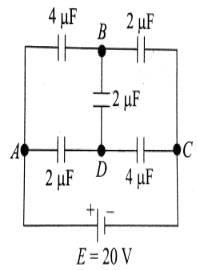
- a)Both the 4mF capacitors carry equal charges in opposite sense
- b)Both the 4mF capacitors carry equal charges in same sense
- c)VB_ VD> 0
- d)VD_ VB> 0
Correct answer is option 'B,C'. Can you explain this answer?
The figure shows a diagonal symmetric arrangement of capacitors and a battery
Identify the correct statements.
Identify the correct statements.

a)
Both the 4mF capacitors carry equal charges in opposite sense
b)
Both the 4mF capacitors carry equal charges in same sense
c)
VB_ VD> 0
d)
VD_ VB> 0
|
|
Shalini Patel answered |
If 2μF where not present between B and D, then potential drop across upper 4μF will be less than potential drop across lower 2μF,i.e.,
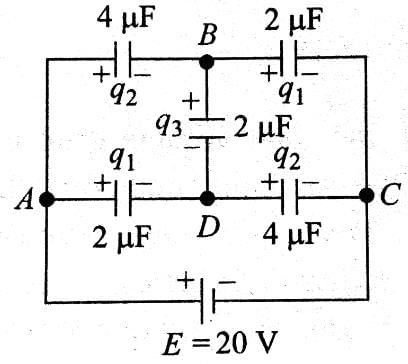

The two plates X and Y of a parallel plate capacitor of capacitance C are given a charge of amount Q each. X is now joined to the positive terminal and Y to the negative terminal of a cell of emf E = Q/C.- a)Charge of amount Q will flow from the negative terminal to the positive terminal of the cell inside it.
- b) The total charge on the plate X will be 2Q
- c)The total charge on the plate Y will be zero
- d)The cell will supply CE2 amount of energy
Correct answer is option 'A,B,C,D'. Can you explain this answer?
The two plates X and Y of a parallel plate capacitor of capacitance C are given a charge of amount Q each. X is now joined to the positive terminal and Y to the negative terminal of a cell of emf E = Q/C.
a)
Charge of amount Q will flow from the negative terminal to the positive terminal of the cell inside it.
b)
The total charge on the plate X will be 2Q
c)
The total charge on the plate Y will be zero
d)
The cell will supply CE2 amount of energy
|
|
Hansa Sharma answered |
As the emf of cell is ϵ=Q/C, charge of amount Q will flow from the positive terminal to the negative terminal of the cell through the capacitor.
As the Y is connected to the negative terminal of the cell so it is ground and the total charge on plate Y will be zero.
Here cell charge the capacitor plate X and its total charge =(Q+Q)=2Q
The energy will supply by cell is U=Cϵ2
As the Y is connected to the negative terminal of the cell so it is ground and the total charge on plate Y will be zero.
Here cell charge the capacitor plate X and its total charge =(Q+Q)=2Q
The energy will supply by cell is U=Cϵ2
Each plate of a parallel plate air capacitor has an area S. What amount of work has to be performed to slowly increase the distance between the plates from x1 to x2 If the charge of the capacitor, which is equal to q or- a)

- b)

- c)

- d)

Correct answer is option 'B'. Can you explain this answer?
Each plate of a parallel plate air capacitor has an area S. What amount of work has to be performed to slowly increase the distance between the plates from x1 to x2 If the charge of the capacitor, which is equal to q or
a)
b)
c)
d)
|
|
Ram Mohith answered |
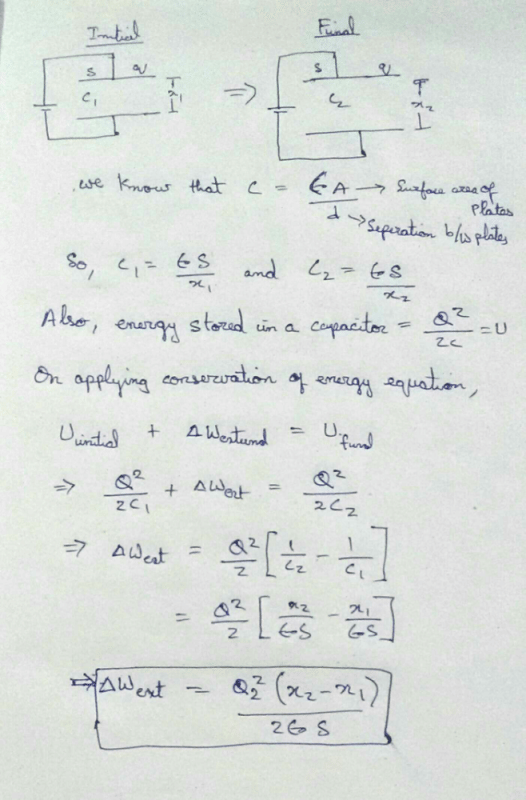
Chapter doubts & questions for Capacitors, Capacitance and Dielectrics - Physics for EmSAT Achieve 2025 is part of EmSAT Achieve exam preparation. The chapters have been prepared according to the EmSAT Achieve exam syllabus. The Chapter doubts & questions, notes, tests & MCQs are made for EmSAT Achieve 2025 Exam. Find important definitions, questions, notes, meanings, examples, exercises, MCQs and online tests here.
Chapter doubts & questions of Capacitors, Capacitance and Dielectrics - Physics for EmSAT Achieve in English & Hindi are available as part of EmSAT Achieve exam.
Download more important topics, notes, lectures and mock test series for EmSAT Achieve Exam by signing up for free.
Physics for EmSAT Achieve
208 videos|329 docs|212 tests
|

Contact Support
Our team is online on weekdays between 10 AM - 7 PM
Typical reply within 3 hours
|
Free Exam Preparation
at your Fingertips!
Access Free Study Material - Test Series, Structured Courses, Free Videos & Study Notes and Prepare for Your Exam With Ease

 Join the 10M+ students on EduRev
Join the 10M+ students on EduRev
|

|
Create your account for free
OR
Forgot Password
OR
Signup on EduRev and stay on top of your study goals
10M+ students crushing their study goals daily

